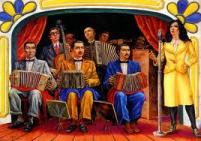Music Danceable As Tango
A tango band of the Golden Age, a.k.a. Orquesta Típica (OT), usually included 3-7 bandoneons, 4 violins, one bass and one piano. The bandoneons, sitting on the front row and playing their characteristic short sharp notes, dominated the sound of the OT. This bandoneón sound drives the tango walk: step (downbeat)-wait-step (downbeat). Since all other steps, like check steps (traspié), turns (giro), runs (corrida), etc.) are derived from the walk, the sound of the bandoneón drives the tango dance.
The sound of tango music, when played for dancing, is unique and needs to be danced with unique steps. Dance steps were developed to follow this sound; in turn, music was composed and played to please the dancers. OT leader Osvaldo Pugliese repeatedly said that he followed his dad's advice: "when you play tango, watch the feet of the dancers". Singer Ángel Vargas requested to have an unobstructed view of the dance floor while performing because he wanted to "sing for the dancers". This feedback resulted in a complete intertwining between music and dance.
Listen to the sound of the bandoneón in the song Guapeando click to play. Recorded by Aníbal Troilo
and his OT in 1941, at the peak of the Golden Age, this sound is clearly aimed at dancers. It is almost impossible not to tango walk to this tune, stepping to the bandoneón downbeat and staying put waiting for the next downbeat (step-wait-step).
The evolution of tango music with time to follow the taste of the public can be appreciated by listening to three different versions of the classic tango Malena sung by three different singers who, at the time of the recordings, were young and very popular.
Malena was premiered in 1942 by the OT of Aníbal Troilo with singer Francisco Fiorentino
and recorded by the same artists the following year. In this recording click to play, the bandoneón is present at all times throughout the song, telling the dancer when to step. Firentino's voice moves from the fore front to the background just like the other instruments in the band, but it never masks the beat. Try to walk to this tune, you'll see how naturally comes the tango walk.
Singer Susana Rinaldi recorded Malena in 1969 click to play, when tango dancing was no longer popular. The bandoneón sound is now absent, the only reason for the song is to present the lyrics. The ensemble accompanying the singer has no name, they are just Rinaldi's musicians. Can you tango walk to this tune?
In 1998, fifteen years into the revival of tango dancing, singer Adriana Varela recorded her version of Malena singing with a contemporary tango band, Sexteto Mayor click to play. Here the bandoneón is back, but timidly. The lyrics still dominate the performance; Varela's voice is never in the background. You could tango walk some segments of this song, but the music is not really driving the walk.
Despite the renewed popularity of tango dancing, the numbers are not there to support bands dedicated to danceable tango music. The tango audience remains largely a listening audience; thus, there is little commercial incentive for the formation of tango bands playing danceable music. Also, the dancing public in Buenos Aires is reluctant to experiment with contemporary bands because the quality of the Golden Age assemblies is so hard to match. The Golden Age music reigns at the milongas.
|

La Orquesta Típica
Oil painting by Antonio Berni, 1939
- The bandoneón, playing short sharp notes,
is the signature instrument of tango music danceable as tango.
-
Read the lyrics (in English and Spanish) and the story
of Malena.
|